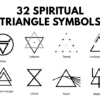
Throughout human history, the concept of creation has been a topic of fascination and wonder. One of the reasons why it has inspired such a diverse array of myths, stories, art, theories, and symbols. Symbols, in particular, have been used as a means to express and understand the mystical nature of the creative process.
These symbols can be found across cultures and traditions, and often reflect the profound connection between the natural world and the divine. From the sacred geometry of the Flower of Life, to the cosmic egg, and the Yin Yang, these symbols offer insights into the mysteries of creation and the forces that shape our world.
In this article, let’s look into the meanings, origins, and significance of some of the most powerful symbols of creation.
20 Ancient Symbols of Creation & Their Deeper Meanings
1. OM
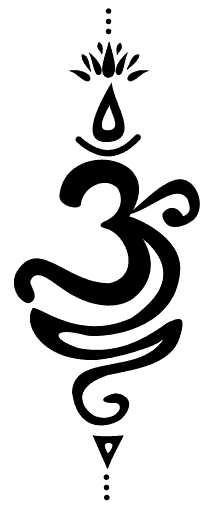
In the ancient Vedic teachings (sacred Hindu texts), OM is considered the sacred primordial sound from which all of creation has emerged.
The word “OM” is composed of three sounds A-U-M (Aaaa, Uooo, Mmmm) that consecutively represent the three cycles of creation which are – creation, preservation, and destruction. The essence of all creation is contained within this mantra. It is believed that chanting OM brings one closer to realizing the ultimate Truth of life.
The Vedas also introduce the concept of ‘Nada Brahma,’ which translates to ‘Sound is God‘ or ‘The Universe is Sound.’ According to this concept, everything in the universe vibrates at a certain frequency, and these vibrations are part of the universal sound – OM. This idea implies that the energy of sound created the entire universe, and every sound gives rise to a form, while every form generates a sound based on its vibrational frequency. Hence, OM is considered the divine sound of creation and is an eternal presence in all that exists.
2. Trimurti
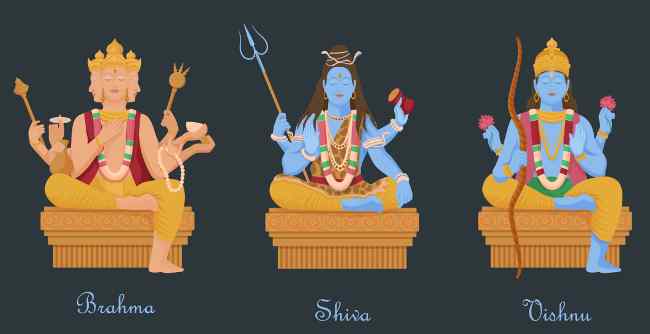
Trimurti is another Hindu concept that represents the cyclic nature of creation. It consists of the three aspects of the Divine: Brahma, Vishnu, and Shiva. Brahma is the creator God who has created the entire Universe. Vishnu is the great preserver who helps maintain the created world. And Mahesh or Shiva is the destroyer who destroys the world with his trident so a new world can eventually emerge from the vestiges of the previous one. The entire Universe and every living thing that exists in it follows these three cycles: birth, life, and death/rebirth.
The symbol of Trimurti also represents the unity of consciousness – the fact that we are all One. The three Gods are individual manifestations of the one supreme being from whom the entire Universe and everything in it have emerged. Every living thing that exists in this Universe is a unique manifestation of the same ultimate reality.
3. The Cosmic Egg

Many ancient cultures believed that the universe was created from an egg. This is why, the symbolism of the Cosmic Egg can be found in different forms across various myths and legends.
For instance, in Hinduism, the Cosmic Egg is known as Hiranya-garbha, meaning “Golden Womb.” According to Hindu creation myth, the Hiranyagarbha was floating around in emptiness for a while before breaking into two halves, which formed the Heavens and the Earth. It was from this egg that the Hindu God of Creation, Brahma, was born. In fact, the Sanskrit word for the universe is Brahmanda (Brahma + Anda) which literally means, the Egg of Brahma.
Similarly, in Chinese mythology, a giant named Pangu was born from a Cosmic Egg, which separated the opposing forces of yin and yang, bringing order to the world.
In the ancient Greek Orphic tradition, there is the concept of the Orphic Egg which hatched the primordial deity Phanes/Protogonus, who created the other gods. The egg is often shown with a serpent around it. According to the myth, Phanes was hatched from the Cosmic egg of Chronos (Time) and Nyx (Night). He created daytime and was the ruler of all deities.
As per Egyptian mythology, Ra (the Sun God) emerged from the cosmic egg and began his journey across the sky dispelling darkness and bringing about life.
In addition, the cosmic egg myth can be found in various other cultures such as Babylonian, Japanese, Polynesian, Finnish, African, and Zoroastrian, among others. Thus the cosmic egg can be seen as the ultimate symbol of creation.
4. Shiva Lingam

Shiva Lingam is another Hindu symbol that represents creation. The Shiva Lingam is a symbolic representation of Lord Shiva, one of the major deities in Hinduism. The Lingam is generally depicted as an elongated oval shape, usually made of stone, with a rounded top and a flat base.
The flat base of the lingam represents Shakti or Divine Feminine energy. The oval-shaped pillar represents Shiva or Divine Masculine energy. It can also represent the brahmanda or cosmic egg. The Shiva Lingam showcases how the union of Shiva and Shakti has given birth to the entire world.
The union of Shiva and Shakti – yin and yang – male and female energy – can be seen in all of creation. By worshipping the Shiva Lingam, an individual plays homage to all of creation.
5. Nataraja
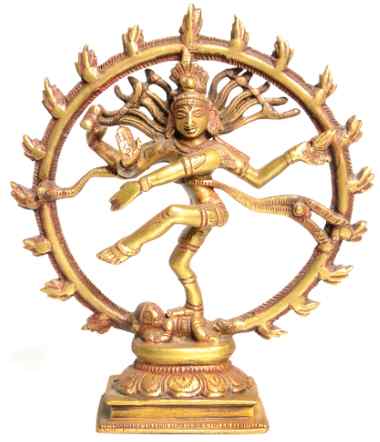
Nataraja is another powerful Hindu creation symbol. The statue of Nataraja symbolizes the cosmic dance of Shiva – the Absolute. A new world is created every single time Shiva lifts his foot and an existing world is destroyed every time Shiva sets his foot down.
The dance happens within a prabha mandala or ring of cosmic light. The circle symbolizes time, which is eternal, having no beginning or end. Both creation and destruction are contained within this eternal circle of time.
Apasmara, the demon of ignorance, lies prostrate under the feet of Shiva representing the illusory and ever-changing nature of the world in which the dance of consciousness takes place.
In his upper right hand, Shiva holds a damaru (an hourglass-shaped drum) from which the primal sound of creation emanates. As discussed earlier, as per the Vedas, the Universe originated from ‘Nada’ – the vibration of sound. As Shiva dances within the cosmic circle of time playing his damaru, with the demon Apasmara at his feet, the cycle of creation and destruction continues unto eternity.
6. Lotus Flower

In Hinduism, the lotus flower represents the cyclical nature of creation. It is believed that Brahma, the creator God, was self-born. He emerged from a lotus flower that was rooted in Vishnu’s navel. Vishnu is the preserver – the one who looks after the world. The story of Vishnu’s birth allegorically represents the creative cycles of birth, life, and death/rebirth. The three creative cycles happen simultaneously. While Vishnu preserves and Shiva destroys, Brahma creates a new world. Just like how Brahma was born from the lotus rooted in Vishnu’s navel, everything that exists comes from the belly of the Universe which is pure consciousness.
Similarly, in Hinduism, all the chakras (spiritual energy centers) in the human body are also represented by lotus flowers. Each lotus flower connected with the corresponding chakra has a varying number of petals. When one is fully attuned to the divine, these lotus flowers blossom fully. The blossoming of the lotus flower in nature symbolizes a human being attaining enlightenment and divine consciousness.
In the physical world, the lotus grows in murky waters but blossoms into a magnificent flower. This process symbolically represents the ideal human life – one shall live in the world but remain untouched by its negativity and darkness while constantly aspiring to merge with the Absolute.
7. Vesica Piscis
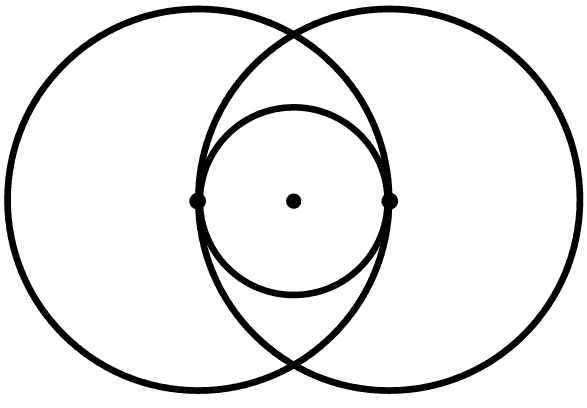
Vesica Piscis (Latin term for “bladder of a fish) is an ancient sacred geometry symbol that is formed by the intersection of two equal circles creating a shape that resembles a pointed oval or almond. It is used in many cultures and religions to represent the concept of creation.
Each circle represents the male (material) and female (spiritual) aspects of creation and the area formed by their intersection (that looks like a pointed oval or almond) represents the union of these aspects. This area is also known as the Cosmic Womb which acts as a sacred portal from where creation occurs.
In Christianity, the Vesica Piscis is used to depict the connection between Christ and his followers. The shape is often used in Christian art to represent the womb of Mary, symbolizing the birth of Christ and the creation of new life.
8. The Shatkona (Shiv-Shakti Star)

The shatkona is made up of two interlocking triangles that come together to form a six-pointed star. The two triangles represent the union of male (Shiva the supreme being) and female (cosmic energy which permeates all of creation) energy. Just like how the union of a human male and female produces a child, creation itself has happened because the supreme male and female energy came together.
The shatkona is connected to the anahat (heart) chakra. It is represented inside the circle of the twelve-petal lotus of the anahat chakra. An open anahat chakra connects us to pure unconditional love which is the very fabric of the Universe. The shatkona inside the anahat chakra signifies that the glory of all creation can be experienced when one is fully connected to one’s heart where unconditional love resides.
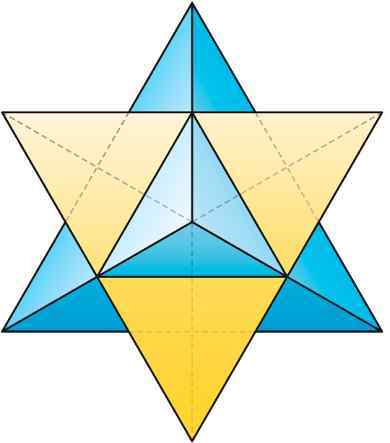
Another symbol that is closely associated with the Shatkona is the Merkaba. In fact, the Merkaba is nothing but a three-dimensional representation of the Shaktkona. It contains two interlocking tetrahedrons and is called the star tetrahedron. It is associated with balance, creation, ascension, and higher consciousness.
Other than Hinduism, this symbol of interlocking triangles is also found in Judiasm as the Star of David. In Judaism, the Star of David represents the connection between God and humanity. The Triangle facing down represents God’s relationship with the world and the one facing up represents the Jewish people’s relationship with God.
9. Sri Yantra

Since Sri Yantra is a geometric representation of the entire Universe. The essence of the entire process of creation is contained within Sri Yantra.
The Sri Yantra is a sacred geometric symbol in Hinduism that represents the union of the divine feminine and masculine energies, and the creation of the universe. The Sri Yantra is made up of nine interlocking triangles, four facing upwards and five facing downwards) that are arranged around a central point, known as the Bindu (or dot).
The upward-pointing triangles represent the divine masculine energy, while the downward-pointing triangles represent the divine feminine energy. Their union, represented by the central dot is the source of all creation. This central dot is sometimes depicted as accompanied by the OM symbol.
The Sri Yantra is considered to be a powerful tool for meditation and spiritual growth and is often used in Hindu temples and households as an object of worship. It is believed that meditating on the Sri Yantra can help one to connect with the divine energies and achieve a state of enlightenment. It is also said to help the seeker connect with the creative forces of manifestation.
10. Seed of Life
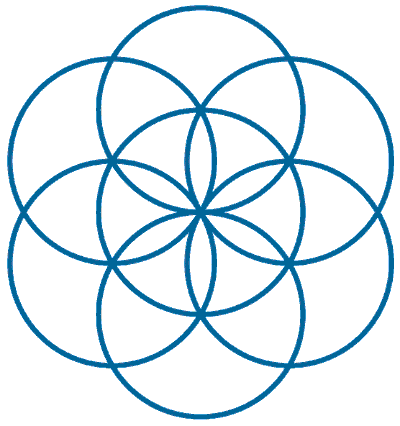
The Seed of Life pattern is formed by drawing the first circle, and then using its circumference as a guide to drawing six more circles around it, with each circle’s center point lying on the circumference of the previous circle. The resulting pattern resembles a six-petaled flower, with each petal formed by the intersection of two circles.

The seven circles that form the symbol signify the seven days of creation, with the central circle representing the seventh day of rest. The 7 circles also represent the 7 Chakras, 7 colors in white light, and the 7 musical notes.
The Seed of Life forms the base for the construction of the Flower of Life pattern (which is another symbol of creation). It also contains within it other sacred geometrical patterns that represent creation like the circle, the Vesica Piscis, and the Shatkona (as seen earlier).

If the Seed of Life is represented in 3D, the 7 circles are replaced with 8 spheres and form what is called the ‘Egg of Life’. What’s interesting is that the formation of the Egg of Life from a single sphere to two, four, six and then eight is exactly similar to cell replication that happens during meiosis.

11. The Flower of Life

The Flower of Life is a sacred geometric symbol found in various cultures throughout history. It is made up of overlapping circles that form an intricate pattern and is believed to contain the patterns of creation and the universe itself.
To create the Flower of Life, you first need to draw seven overlapping circles to form the Seed of Life (as we saw earlier). Adding more overlapping circles, you create the basic 19-circle flower of life. Thereafter, you can keep adding circles and the pattern will keep expanding outwards forming a concentric hexagonal ring of circles. Thus, the flower of life also represents the infinite nature of the universe.
The interesting point to note is that the flower of life contains within it various other sacred geometric symbols also associated with creation. These include the Vesica Pieces, Triquetra, Hexafoil, Seed of Life, Kabalistic Tree of Life, Shatkona (Six-Pointed Star or Star of David), Fruit of Life, Egg of Life, Metatron’s Cube and the Merkaba.
The Flower of Life is believed to hold the secrets of the universe, and is often used as a tool for meditation and spiritual growth. It is thought that by meditating on the Flower of Life, one can access deeper levels of consciousness and gain insight into the workings of the universe.
12. Kundalini – The Coiled Snake

In the yogic tradition, Kundalini energy is considered to be the supreme creative force of the Universe. It is portrayed as a coiled snake that remains asleep at the base of the spine until it is awakened through intense spiritual practices. When the kundalini energy is awakened, it rises up flooding each chakra (energy center) with divine spiritual energy. When kundalini energy reaches the Sahasrara chakra located at the top of the skull one merges fully with Para Brahman – the Absolute.
The awakening of the kundalini is the most important event in one’s spiritual journey. It illuminates the path to self-discovery and enlightenment. The seeker with the awakened kundalini energy can tap into the creative forces of the Universe to manifest anything and everything.
13. Yin Yang

The Yin Yang symbol is a powerful and ancient Chinese symbol that is often associated with the concept of creation. The symbol is made up of two halves, with one half being black and the other half white, and they are intertwined to form a circle.
In Taoist philosophy, the Yin Yang symbol represents the balance between opposing forces in the universe. The black half, or yin, represents the feminine energy of darkness, earth, and intuition. The white half, or yang, represents the masculine energy of light, heaven, and logic. Together, they represent the complementary nature of these opposing forces and their role in the creation and sustenance of the universe.
It is to be noted that the black half of the symbol contains a bit of white and the white half contains a bit of black. This suggests that the feminine contains the masculine and the masculine contains the feminine.
The Yin Yang symbol is often associated with the concept of chi, which is the vital life force energy that flows through all living things. According to Taoist philosophy, chi flows through the body along meridians, and the balance of yin and yang energies is essential for the proper flow of chi. When the yin and yang energies are balanced, the body is healthy, the mind is clear, and your creative energy is at its peak.
In Chinese creation mythology (as we saw earlier), the giant Pangu was said to be born from a Cosmic Egg. Pangu is believed to have separated the opposing forces of Yin and Yang, which brought order to the world.
14. Kalachakra

The Kalachakra mandala or the wheel of time is an important symbol in Tibetan Buddhism. The word kalchakra combines two Sanskrit words: kala (time) and chakra (wheel). Kalchakra represents the cyclical nature of creation. No matter what happens, the wheel of time keeps moving, thereby, continuing the cycles of creation, preservation, and destruction. These teachings originated in India and were later incorporated into Tibetan Buddhism.
Almost all ancient cultures and religious traditions around the world believe that creation is already complete. All that has been, can be, and will be already exists in the here and now. Time is not something linear. It is akin to a giant painting. At any given point, our eyes can see only a small part of that gigantic painting but that doesn’t mean the entire image doesn’t exist in the here and now. Similarly, we are alive in the present moment but the past and the future also exist within this present moment.
15. Koru (Maori symbol)

The Koru is a sacred symbol in Maori culture, representing creation, spiritual enlightenment, and the interconnectedness of all things in the universe. It is based on the shape of an unfurling fern leaf (as shown in the image below), with the circular shape representing the eternal cycle of life and the beginning point of the spiral symbolizing the source of all creation.

The spiral emanates outward, representing growth and evolution. Alternatively, the spiral can also be viewed as moving from outside to inside, symbolizing a return to the source or getting in touch with one’s spiritual nature.
16. Menorah (Jewish)

The Menorah is a seven-branched candelabrum and is one of the oldest symbols of Judaism. It represents divine light, wisdom, and creation. The seven lights of the Menorah are highly significant, as they represent the seven days of creation as described in the Hebrew Bible.
According to the book of Genesis, God created the world in six days and rested on the seventh. Each of the seven branches represents one day of creation. In fact, the Monorah was originally lit one day at a time until all seven lights were glowing at the end of the week to signify the act of creation.
17. Navajo Ceremonial Basket

The Navajo Ceremonial Basket is a powerful symbol of creation for the Navajo people of North America. These baskets are used in religious ceremonies and represent the Navajo creation story, which tells of how the world was created by the gods and how souls travel from the spirit world to the material world and vice versa.
The central spot in the basket represents the sipapu, or the point of origin (or source) from which everything gets created. The inner coils of the basket are white in color and represent birth into the material world. The red bands in the basket represent familial bonds and the creation of a family. The white outer rim of the basket represents the spirit world.
The most important part of the symbol is the line that starts from the center of the basket and connects to the outer rim. This line connects the material world to the spirit world. This is the pathway from where souls can enter into the material world from the spirit world. The line also represents the fact that you can always access the spiritual world (from the material world) for guidance and direction. Thus the line symbolizes wisdom and spiritual journey.
A few other symbols that are related are the Native American Medicine Wheel and the Congo Cosmogram.
18. Hammer & anvil

The hammer and anvil are two tools that are used in the process of shaping metal. The hammer is used to strike the metal, while the anvil is used to provide a solid surface for the metal to be struck upon.
Thus the hammer represents the masculine or active energy and the Anvil represents the feminine or passive energy, both of which are required for creation to happen.
The hammer and anvil symbol can also be interpreted more broadly as a representation of the creative process. The hammer represents the force of creativity, while the anvil represents the solid foundation upon which that creativity can be expressed. Together, they represent the process of bringing ideas and visions into a tangible form, whether that be through art, music, writing, or any other form of creative expression.
19. Spiral, Double Spiral & Triple Spiral

The spiral, double spiral, and triple spiral (also known as Triskle) are ancient symbols that have been found in various cultures throughout the world. All three represent the idea of creation.
The center of the spiral represents the source from which everything emanates. Thus, starting from the center of the spiral and moving outward represents the process of creation and evolution. It also represents growth, expansion, and transformation. Similarly, starting from the outside and moving toward the center represents returning back to the source.

The double spiral, or the two interlocking spirals, is a symbol of balance, harmony, and interconnectedness of all things. It represents the duality of existence, the interplay of opposites, and the balance of masculine and feminine energies that is required for the process of creation.
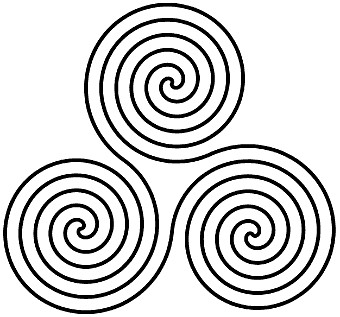
The Triskele or Triskelion, also known as the triple spiral, is a symbol that represents the threefold nature of existence and the cycle of creation, which involves birth, death, and rebirth. It symbolizes various threefold concepts, such as past, present, and future; earth, sea, and sky; mind, body, and spirit; and many more, making it a versatile symbol in different cultures.
20. Tree of Life

The Tree of Life has been associated with creation by various cultures all over the world. For instance, as per Celtic, Norse, and Mayan mythology, the Tree of Life, stands in the center of the universe (Axis Mundi) connecting all three realms of existence. The roots of the tree reach deep into the underworld, the trunk stays in the earthly plane, and the branches connect with the heaves. This way the Tree of Life acts as a portal between these realms facilitating the soul’s journey from the spirit world to the material world.
Similar stories exist in various other cultures, for instance as per Zulu mythology, the Tree of Life is believed to have given birth to all living beings, the first being a bird named Ingonghulu (an eagle). The bird extended her wings and beat them to announce the beginning of creation. In Hinduism, the Tree of Life is represented by the Ashvattha tree, with its roots in heaven and branches spreading down to earth. The tree symbolizes the cycle of birth, death, and rebirth, and the different stages of spiritual evolution. Similarly, the Egyptians believed that Goddess Lusaaset the Primordial goddess and giver of life, resides in the Tree of Life. Turkish mythology believes the Tree of Life was planted by the creator God Kayra Han, and the birth goddess, Kübey Hatun, resides in the tree. Er Sogotoh, the first human and ancestor of all people on earth is considered to be the offspring of the goddess. The Tree of Life, therefore, represents the source of all life.
Conclusion
Symbols of creation are a fascinating aspect of human culture and mythology. They represent the birth of new life, the cycle of life, and the interconnectedness of all things. These symbols have been used by ancient civilizations around the world to express their beliefs about the origins of the universe and the meaning of life. They continue to be powerful symbols that resonate with people to this day, connecting us to our spiritual nature and the source of all creation.
If a symbol on this list resonated with you, considering meditating on that symbol or using it in your spiritual practice as that can help you gain powerful insights into its deeper symbolism and hidden meanings.


